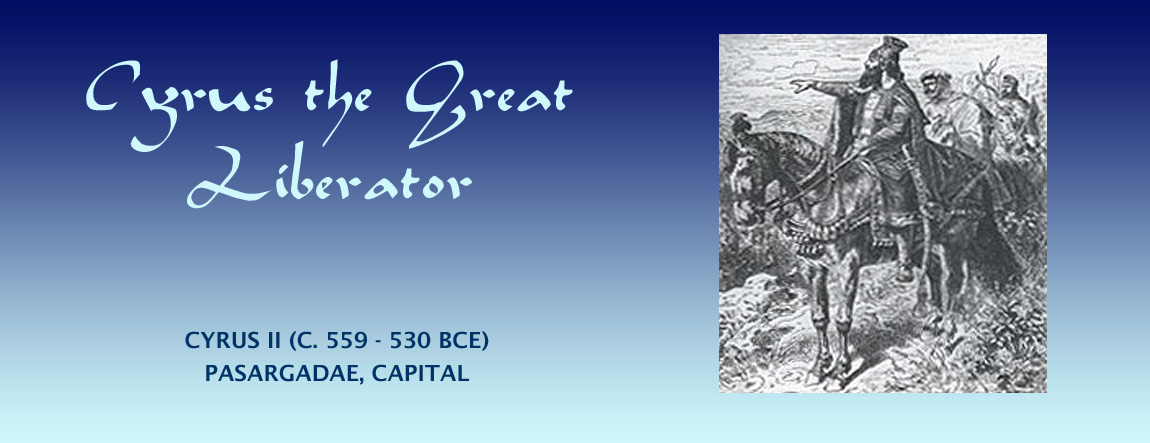
Contents
Cyrus the Great
Cyrus the Great & Cyrus Cylinder Series
|
Page 2: Pasargadae, Capital of Cyrus
Site Location & Structures
King Cyrus II, the Great, located his capital city, palace and tomb at Pasargadae (or Pasargad / Pasargada). Pasargadae is situated on the Dasht-e Morghab, the plain of Morghab, some 25 kilometres long and 12 kilometres wide. The name was derived from the earlier Old Persian Batrakatash and later Old Persian Pathragad.
According to Strabo (c. 62 BCE - c.24 CE) in his Geography 15.3.8, the Cyrus built Pasargadae on the site where, in 550 BCE, he had defeated the Medes commanded by King Astyages.
 |
Google Satellite relief map of the Marv Dasht (large green area) valley plains and Persian historical sites.
Brown areas are surrounding hills
click to see a larger map |
Pasargadae is also located in the valley of the river Polvar. In ancient times, there were at least eight dams that regulated the river and stored water for irrigation.
 |
| The Polvar River that runs through the plains of Morghab, the Dasht-e Morghab |
The present site is 1.6 square kilometres in size and includes the structure commonly believed to be the mausoleum of Cyrus (shown in page 1), the Tall-e Takht fortress that sits on top of a small hill, the audience and royal residential palaces, and gardens, the earliest known example of the chahar bagh, meaning four-garden, design. For a more detailed discussion on the chahar bagh design please see our page on Persian Gardens.
 |
View of the Pasargadae site looking South-west across the Dasht-e Morghab
from Tall-e Takht, a fortress built on a small hill |
 |
| A close up of the Pasargadae site from Tall-e Takht |
 |
| Google Satellite view showing location of the structures at the Pasargadae site |
Palace Complex
 |
Layout of the Pasargadae palace complex
Gate A is the entrance building to the complex
Palace S, situated just across the river is the apadana or audience hall
The chahar bagh gardens are flanked by pavilions A and B
Palace P is thought to be the private royal residence |
 |
| Entrance gate house to the Pasargadae palace complex |
 |
| Reconstruction drawing of the apadana or audience hall at Pasargadae |
 |
| Pavilion B with Tall-e Takht fortress in the background |
 |
| Ruins of the structure thought to be the private royal residence at Pasargadae |
Tall-e Takht
 |
| Remnant of a wall of the Tall-e Takht fortress |
Tall means hill and takht means throne. The name Tall-e Takht means Hill of the Throne or Throne Hill. The fortress guarded the surrounding area.
» Page 1
At our blogsite:
» Cyrus the Great - His Religion & Inspiration
» Cyrus the Great - Information Sources
» Cyrus the Great - Hebrew Bible Quotes
» Cyrus Cylinder
» Cyrus Cylinder - its Discoverer Hormuzd Rassam
» Cyrus Cylinder - Contents (Eduljee)
» Cyrus Cylinder - Translation (Rogers)
» Cyrus Cylinder - Translation (Finkel)
» Cyrus Cylinder - its Remarkable Discovery
» Cyrus' Edict & the Chinese Cuneiform Bones
» Cyrus Cylinder: Talk by Neil MacGregor, Dir. British Museum
|
|











